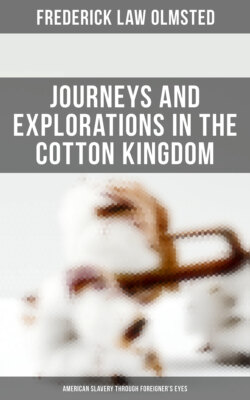Journeys and Explorations in the Cotton Kingdom: American Slavery Through Foreigner's Eyes

Реклама. ООО «ЛитРес», ИНН: 7719571260.
Оглавление
Frederick Law Olmsted. Journeys and Explorations in the Cotton Kingdom: American Slavery Through Foreigner's Eyes
Journeys and Explorations in the Cotton Kingdom: American Slavery Through Foreigner’s Eyes
Reading suggestions
CHAPTER I. INTRODUCTORY. THE PRESENT CRISIS
CHAPTER II. THE JOURNEY FROM WASHINGTON
CHAPTER III
CHAPTER IV. THE ECONOMY OF VIRGINIA
CHAPTER V. VIRGINIA AND ITS ECONOMY — CONTINUED
CHAPTER VI. SOUTH CAROLINA AND GEORGIA, SURVEYED
CHAPTER VII. THE SOUTH-WEST, ALABAMA AND MISSISSIPPI
CHAPTER VIII. MISSISSIPPI AND LOUISIANA
CHAPTER IX. FROM LOUISIANA THROUGH TEXAS
Отрывок из книги
Frederick Law Olmsted
CHAPTER I INTRODUCTORY THE PRESENT CRISIS
.....
I can answer in part at least.
I have been on plantations on the Mississippi, the Red River, and the Brazos bottoms, whereon I was assured that ten bales of cotton to each average prime field-hand had been raised. The soil was a perfect garden mould, well drained and guarded by levees against the floods; it was admirably tilled; I have seen but few northern farms so well tilled: the labourers were, to a large degree, tall, slender, sinewy, young men, who worked from dawn to dusk, not with spirit, but with steadiness and constancy. They had good tools; their rations of bacon and corn were brought to them in the field, and eaten with efficient despatch between the cotton plants. They had the best sort of gins and presses, so situated that from them cotton bales could be rolled in five minutes to steamboats, bound direct to the ports on the gulf. They were superintended by skillful and vigilant overseers. These plantations were all large, so large as to yet contain much fresh land, ready to be worked as soon as the cultivated fields gave out in fertility. If it was true that ten bales of cotton to the hand had been raised on them, then their net profit for the year had been, not less than two hundred and fifty dollars for each hand employed. Even at seven bales to the hand the profits of cotton planting are enormous. Men who have plantations producing at this rate, can well afford to buy fresh hands at fourteen hundred dollars a head. They can even afford to employ such hands for a year or two in clearing land, ditching, leveeing, fencing, and other preparatory work, buying, meantime, all the corn and bacon they need, and getting the best kind of tools and cattle, and paying fifteen per cent. Per annum interest on all the capital required for this, as many of them do. All this can be well afforded to establish new plantations favourably situated, on fresh soil, if there is a reasonable probability that they can after all be made to produce half a dozen seven-bale crops. And a great many large plantations do produce seven bales to the hand for years in succession. A great many more produce seven bales occasionally. A few produce even ten bales occasionally, though by no means as often as is reported.
.....